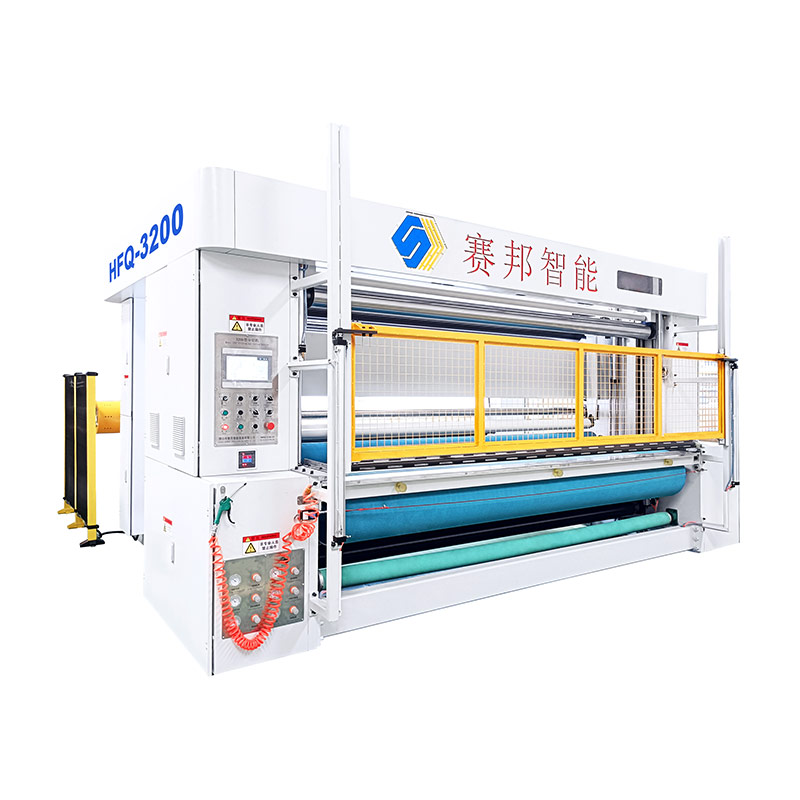What Are the Different Types of Slitting Machines?
A Slitting Machine is an industrial device used to cut large rolls of materials — such as nonwoven fabrics, films, paper, and laminated products — into narrower and more manageable rolls. This process, called slitting or rewinding, is essential for industries that rely on flexible materials in large continuous rolls.
At Foshan Saibang Intelligent Equipment Co., Ltd., we design and manufacture advanced slitting machines that combine high precision, automation, and efficiency. Our products are widely used across nonwoven, coating, packaging, paper converting, and film lamination industries, offering excellent adaptability to different materials and production requirements.
This article explains what slitting machines are, the different types available, their applications, and a summary of their advantages in industrial production.
1. What Is a Slitting Machine?
A slitting machine, sometimes called a slitter rewinder, is designed to cut a master roll into multiple smaller rolls with precise width specifications. The machine accomplishes this through a series of cutting blades, tension rollers, and winding systems that control the speed and pressure of the material during processing.
Key Components:
| Component | Function |
|---|---|
| Unwinding unit | Holds and unwinds the large master roll smoothly. |
| Slitting section | Contains circular or razor blades to cut materials into required widths. |
| Tension control system | Maintains consistent web tension to prevent wrinkles or stretching. |
| Rewinding system | Collects the slit strips onto separate cores for packaging or further processing. |
| PLC control interface | Allows for automated operation and precision adjustments. |
The working principle is simple but highly technical: the machine feeds material through rollers, adjusts the cutting tension, and rewinds the finished rolls simultaneously, ensuring precise, even edges at high speeds.
2. Different Types of Slitting Machines
Slitting machines can be classified based on their cutting method, material compatibility, and application field. Each type serves a specific purpose and offers distinct advantages depending on the production requirements.
A) Razor Blade Slitting Machine
This type uses razor blades for cutting thin materials like plastic films or laminates.
Advantages: Provides clean cuts with minimal dust generation.
Best for: Thin films (PET, PVC, BOPP), aluminum foils, and coated paper.
Typical Speed: Up to 1200 m/min.
| Parameter | Description |
|---|---|
| Material thickness | 10–150 μm |
| Blade setup | Fixed razor holder |
| Industries | Flexible packaging, printing film, medical wrap |
B) Shear Slitting Machine
Shear slitting employs a male and female rotary knife pair, similar to scissors, to cut thicker materials.
Advantages: High durability, excellent for dense or layered substrates.
Best for: Nonwoven fabrics, kraft paper, rubber sheets, and laminated films.
Typical Speed: 500–2000 m/min.
| Feature | Benefit |
|---|---|
| Adjustable knife angle | Allows cutting of multiple thickness levels |
| Clean edge finish | Prevents material tearing |
| Long blade life | Suitable for heavy-duty industrial runs |
Saibang’s PQ-4600 Nonwoven Slitting Machine uses shear cutting technology, designed for wide-width rolls up to 4600 mm, offering stable tension and precision cutting at high speeds.
C) Crush-Cut Slitting Machine
In a crush-cut system, a rotary blade presses the material against a hardened anvil roller. It is ideal for soft or compressible materials that are hard to shear cleanly.
Advantages: Effective for elastic or multilayer products.
Best for: Foam, nonwoven fabrics, and pressure-sensitive materials.
Speed: 200–600 m/min.
| Material Type | Example Products | Output Quality |
|---|---|---|
| Soft nonwoven | Hygiene products, wet wipes | Smooth, consistent rolls |
| Elastic films | Medical bandages | Stable edges, no tearing |
| Laminated foams | Soundproof materials | Maintains lamination integrity |
D) Rewind Slitting Machine (Slitter Rewinder)
This versatile system performs both slitting and rewinding simultaneously.
Advantages: Ideal for high-volume production with different material types.
Features: Dual shafts for separate winding tension, automatic roll change, and edge trimming.
Best for: Film, paper, coating materials, and textile laminates.
Saibang’s PQ-3000 and PQ-2600 models are advanced slitter rewinders featuring automatic web tension control, touch-screen operation, and dual-shaft rewinding, making them ideal for nonwoven and laminated paper industries.
E) Specialized Slitting Machines by Application
Saibang Intelligence designs various customized slitting solutions tailored for specific industries:
| Machine Model | Cutting Width | Application Field | Compatible Materials |
|---|---|---|---|
| PQ-4600 | 4600 mm | Hygiene / Nonwoven Production | Spunbond, melt-blown, hot air nonwoven |
| PQ-3000 | 3000 mm | Coating / Lamination | Puffing paper, laminated film |
| PQ-24B | 2500 mm | Multi-material | Nonwoven, paper, film |
| PQ-16A | 1600 mm | Film and Paper Converting | Laminated film, air-laid paper |
Each machine integrates PLC automation, servo tension control, and synchronous winding motors to deliver stable cutting accuracy and minimal waste. With Saibang’s engineering expertise, customization for unique roll widths, thicknesses, or materials is fully supported.
3. Applications of Slitting Machines
Slitting machines are essential for various industries that process materials in roll form. Their applications span from medical and hygiene products to packaging, printing, and insulation materials.
A) Nonwoven Fabric Industry
Used for hygiene products such as face masks, sanitary materials, medical gowns, and filters.
Requires soft cutting edges to prevent fiber damage.
Saibang’s nonwoven slitters use anti-static systems and air-cooled blades for clean processing.
B) Film and Packaging Industry
Handles BOPP, PET, PVC, and PE films used in food packaging and label printing.
Demands high precision and edge stability to prevent film curling.
Razor or shear systems are typically preferred.
C) Paper and Laminating Industry
Used to cut large reels of coated, laminated, or kraft paper into smaller rolls.
Ideal for bookbinding, printing, or cardboard lamination.
Saibang’s film and Paper Slitting Machines deliver tight roll winding with no dust generation.
D) Textile and Coating Industry
Processes fabric laminates, hot air nonwovens, and puffing paper for upholstery and decoration.
The machine’s multi-roller feeding system ensures even web distribution.
Prevents stretching or heat deformation of delicate coatings.
| Industry | Example Materials | End Products |
|---|---|---|
| Hygiene | Melt-blown, spunbond nonwoven | Masks, diapers, gowns |
| Packaging | PET film, laminated film | Food packaging, labels |
| Printing | Coated and kraft paper | Books, magazines |
| Construction | Laminated insulation | Acoustic panels |
Summary
A slitting machine is a vital part of modern industrial manufacturing, converting wide rolls into narrower, usable formats with precision and efficiency. Different types—razor, shear, crush-cut, and slitter rewinder machines—each serve specialized purposes based on material properties and industry needs.
Key takeaways:
Razor slitters excel in thin films and flexible packaging.
Shear slitters dominate nonwoven and heavy-duty applications.
Crush-cut systems are best for soft or elastic substrates.
Slitter rewinders combine versatility and automation for large-scale production.
At Foshan Saibang Intelligent Equipment Co., Ltd., our slitting machines represent decades of innovation, integrating intelligent control systems, servo-driven precision, and customizable configurations to meet global industrial demands.
From nonwoven hygiene materials to advanced laminated films, Saibang’s slitting equipment ensures maximum productivity, minimal waste, and long-term reliability.



